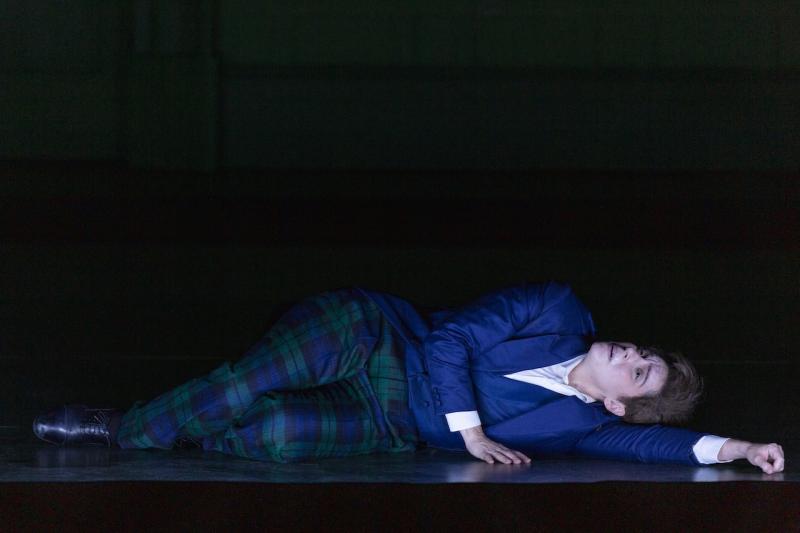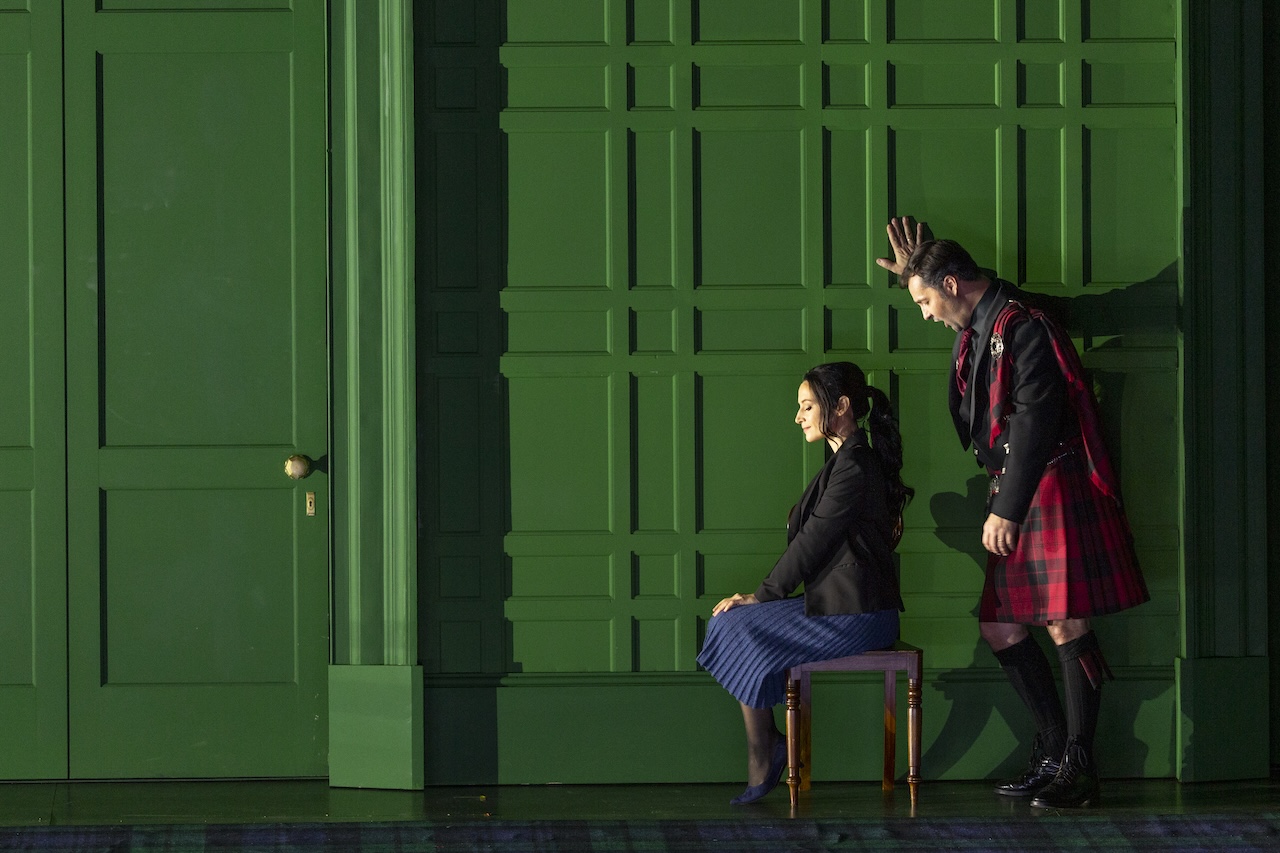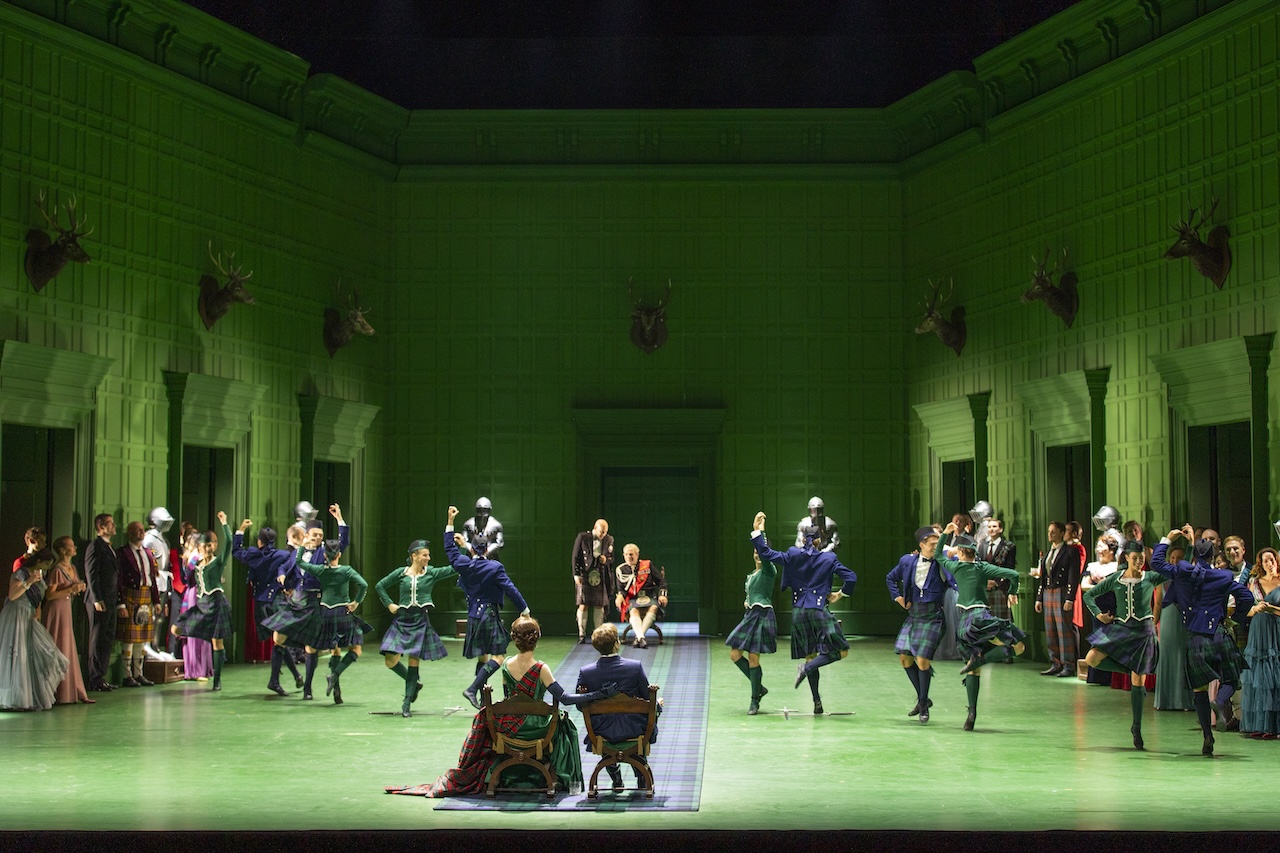Ariodante: Raphaël Pichon, Ensemble Pygmalion, Opéra Garnier, Paris review - a blast of Baroque beauty | reviews, news & interviews
Ariodante: Raphaël Pichon, Ensemble Pygmalion, Opéra Garnier, Paris review - a blast of Baroque beauty
Ariodante: Raphaël Pichon, Ensemble Pygmalion, Opéra Garnier, Paris review - a blast of Baroque beauty
A near-perfect night at the opera

The revival of Robert Carsen’s production of Handel’s Ariodante at the Opéra Garnier in Paris under the direction of Raphaël Pichon, with his Ensemble Pygmalion and a top-notch cast, is well worth a trip to Paris. At over four hours, it might seem daunting, but the show is as close to perfection as opera can be, bursting with vitality and emotion, and never feels a second too long.
There are plenty of totally beguiling moments, but the high-point of the performance is provided by the young Italian mezzo-soprano Cecilia Molinari. In the title role, she doesn’t just provide the beating heart of the emotional roller-coaster of a narrative but takes us on a ride in which skill, confidence, charisma and versatility make for a truly exceptional experience.
Set in the royal court of Scotland, evoked with humour, fantasy and more than a nod to parallels with Britain’s current Royal Family, the opera tells a story of love, jealousy, subterfuge and betrayal. The first act celebrates the love of Ariodante, and his fiancée Ginevra, the daughter of the King – a young innocent who will be caught in a web of intrigue, sung with grace by Jacquelyn Tucker. The pure texture of her voice suits the slightly one-dimensional predictability of her character, little more than a victim of the treacherous schemes of Polinesso, the Duke of Albany – wonderfully played and sung by countertenor Christophe Dumaux. Polinesso is the bad boy you love to hate. The French singer, who has made the role his own for a while now, and brings it to Covent Garden in the New Year, manages to portray ruthless ambition – he wants to steal the princess Ginevra so that he may succeed the current monarch – with cunning and irresistibly devilish charm. He may not have the vocal strength he displayed a few years ago – but his rendition of Coperta la frode displays a remarkable command of vocal ornamentation, and an agility that at times defies belief. Polinesso exploits the infatuation of Dalinda, (pictured above) Ginevra’s lady-in-waiting, who will impersonate her mistress at the villain’s instigation and cause havoc with the impending marriage. Sabine Devieilhe brings convincing skill to the part, navigating the emotional changes that characterise her role with deftness and physical presence. A high coloratura soprano, well-contrasted with Jacquelyn Tucker’s fuller vocal texture, she is a delight to watch and hear, but some of her top notes – demanding a testing level of virtuosity – were, on the strength of this performance, close to shrill. The rest of the singers are all perfectly cast, all of them skilled actors, who navigate their respective arias with brio. Tenor Ru Charlesworth, as Ariodante’s brother Lurcanio, contrasts with great feeling and skill, the young man’s shy reserve – as in his opening aria "Bel mio sol vezozzi rai" – with a more feisty warrior self that emerges in Acts II and III. Luca Tittoto, as the King, brings just the right amount of gravitas to the part, with a warm and mellow bass voice. He moves with subtlety and grace, never overdoing things. Carsen often places the singers before a drop-down screen – a device which allows for hidden scene changes, but brings the singers in more direct contact with the orchestra and audience in a way that creates the intimacy that these emotionally-charged monologues aspire to.
Polinesso exploits the infatuation of Dalinda, (pictured above) Ginevra’s lady-in-waiting, who will impersonate her mistress at the villain’s instigation and cause havoc with the impending marriage. Sabine Devieilhe brings convincing skill to the part, navigating the emotional changes that characterise her role with deftness and physical presence. A high coloratura soprano, well-contrasted with Jacquelyn Tucker’s fuller vocal texture, she is a delight to watch and hear, but some of her top notes – demanding a testing level of virtuosity – were, on the strength of this performance, close to shrill. The rest of the singers are all perfectly cast, all of them skilled actors, who navigate their respective arias with brio. Tenor Ru Charlesworth, as Ariodante’s brother Lurcanio, contrasts with great feeling and skill, the young man’s shy reserve – as in his opening aria "Bel mio sol vezozzi rai" – with a more feisty warrior self that emerges in Acts II and III. Luca Tittoto, as the King, brings just the right amount of gravitas to the part, with a warm and mellow bass voice. He moves with subtlety and grace, never overdoing things. Carsen often places the singers before a drop-down screen – a device which allows for hidden scene changes, but brings the singers in more direct contact with the orchestra and audience in a way that creates the intimacy that these emotionally-charged monologues aspire to.
Carsen’s flawless direction is well-served by Luis F. Carvalho’s costumes and set – all Highland blues and greens, as if transported into the texture of a tartan weave – that never upstages the singers or the action. The lighting too, by Peter van Praet, plays most skilfully with the menace of shadows and shifts in mood. Today’s Handel invites gimmicks, sometimes over-pretentious, the product of over-thinking and misplaced desire to make Baroque new. Carsen seems to have followed his creative instincts and the intelligent approach he has favoured, with humorous references to our benighted Royals, passionate hunters of large Highland beasts, and hunted themselves by hordes of hungry paparazzi, feels both bold and just right. The claustrophobia of the hermetically sealed universe of the Scottish palace, where servants are ready to do their servile best at every instant, and where intrigue unfolds in plain sight – all of this serves the opera’s narrative arc, from pre-marital bliss to the horror of betrayal and back again to a joyful finale.  The pacing is well-judged, and led in a most inspired fashion by Raphaël Pichon’s confident mastery of one of Handel’s most beautiful scores. Pichon is now well-established as one of today’s masters of the Baroque repertoire. His relationship with Pygmalion is one of equals. Although possessed of extraordinary presence, he is certainly not an egomaniac of a maestro. He makes common cause with the musicians, who are in tune with his mission: to make this music as bright and new as when it was first composed and performed. There are – as has sometimes been the case with his tempi – moments that are taken a little too fast, but they are few. He knows how to go with the flow of different moods, all of which serve the rich and varied emotional narrative that makes this one of Handel greatest operatic works.
The pacing is well-judged, and led in a most inspired fashion by Raphaël Pichon’s confident mastery of one of Handel’s most beautiful scores. Pichon is now well-established as one of today’s masters of the Baroque repertoire. His relationship with Pygmalion is one of equals. Although possessed of extraordinary presence, he is certainly not an egomaniac of a maestro. He makes common cause with the musicians, who are in tune with his mission: to make this music as bright and new as when it was first composed and performed. There are – as has sometimes been the case with his tempi – moments that are taken a little too fast, but they are few. He knows how to go with the flow of different moods, all of which serve the rich and varied emotional narrative that makes this one of Handel greatest operatic works.
The vitality of the Ensemble Pygmalion’s playing energised by Pichon’s fiery engagement and enjoyment of the music works especially well in the dances that close Acts I and II Choreographed by Nicolas Paul, they play with tropes of Highland dancing, in a way that may not be true to the dances that Marie Sallé made for the first performances of the opera at Covent Garden in 1735, but bring a lightness to the production that is both intelligent and pure fun.
The sum of the production’s magnificent parts comes together most powerfully in two of Ariodante’s arias, sung by Cecilia Molinari with a level of excellence that announces a major new star. In the slow lament, as she expresses the most abject sorrow on learning of her fiancé’s death and her father’s rejection, "Scherza infida", she combines breathtaking technical virtuosity, a command of every tiny detail of vocal ornamentation with an extraordinary sense of the music’s logic as well as its emotional charge. The aria is known for the stirring obligato from a row of bassoons, a sound so mournful that it tears at the heart. Pichon takes the pace as slowly as can be, drawing the maximum out of the music and Molinari’s voice, as the mezzo perfectly calibrates the changing volume of her song with extraordinary and almost supernatural subtlety. In contrast, when she is freed from sorrow and sings with joy in the bravura aria "Dopo notte, altra et funesta", Pichon coaxes contagious vigour from the Pygmalion musicians, in an irrepressible moment of baroque feelgood joy.
The future of Arts Journalism
You can stop theartsdesk.com closing!
We urgently need financing to survive. Our fundraising drive has thus far raised £49,000 but we need to reach £100,000 or we will be forced to close. Please contribute here: https://gofund.me/c3f6033d
And if you can forward this information to anyone who might assist, we’d be grateful.

Subscribe to theartsdesk.com
Thank you for continuing to read our work on theartsdesk.com. For unlimited access to every article in its entirety, including our archive of more than 15,000 pieces, we're asking for £5 per month or £40 per year. We feel it's a very good deal, and hope you do too.
To take a subscription now simply click here.
And if you're looking for that extra gift for a friend or family member, why not treat them to a theartsdesk.com gift subscription?
more Opera
 Ariodante: Raphaël Pichon, Ensemble Pygmalion, Opéra Garnier, Paris review - a blast of Baroque beauty
A near-perfect night at the opera
Ariodante: Raphaël Pichon, Ensemble Pygmalion, Opéra Garnier, Paris review - a blast of Baroque beauty
A near-perfect night at the opera
 Cinderella/La Cenerentola, English National Opera review - the truth behind the tinsel
Appealing performances cut through hyperactive stagecraft
Cinderella/La Cenerentola, English National Opera review - the truth behind the tinsel
Appealing performances cut through hyperactive stagecraft
 Tosca, Royal Opera review - Ailyn Pérez steps in as the most vivid of divas
Jakub Hrůša’s multicoloured Puccini last night found a soprano to match
Tosca, Royal Opera review - Ailyn Pérez steps in as the most vivid of divas
Jakub Hrůša’s multicoloured Puccini last night found a soprano to match
 Tosca, Welsh National Opera review - a great company reduced to brilliance
The old warhorse made special by the basics
Tosca, Welsh National Opera review - a great company reduced to brilliance
The old warhorse made special by the basics
 BBC Proms: The Marriage of Figaro, Glyndebourne Festival review - merriment and menace
Strong Proms transfer for a robust and affecting show
BBC Proms: The Marriage of Figaro, Glyndebourne Festival review - merriment and menace
Strong Proms transfer for a robust and affecting show
 BBC Proms: Suor Angelica, LSO, Pappano review - earthly passion, heavenly grief
A Sister to remember blesses Puccini's convent tragedy
BBC Proms: Suor Angelica, LSO, Pappano review - earthly passion, heavenly grief
A Sister to remember blesses Puccini's convent tragedy
 Orpheus and Eurydice, Opera Queensland/SCO, Edinburgh International Festival 2025 review - dazzling, but distracting
Eye-popping acrobatics don’t always assist in Gluck’s quest for operatic truth
Orpheus and Eurydice, Opera Queensland/SCO, Edinburgh International Festival 2025 review - dazzling, but distracting
Eye-popping acrobatics don’t always assist in Gluck’s quest for operatic truth
 MARS, Irish National Opera review - silly space oddity with fun stretches
Cast, orchestra and production give Jennifer Walshe’s bold collage their all
MARS, Irish National Opera review - silly space oddity with fun stretches
Cast, orchestra and production give Jennifer Walshe’s bold collage their all
 Káťa Kabanová, Glyndebourne review - emotional concentration in a salle modulable
Janáček superbly done through or in spite of the symbolism
Káťa Kabanová, Glyndebourne review - emotional concentration in a salle modulable
Janáček superbly done through or in spite of the symbolism
 Buxton International Festival 2025 review - a lavish offering of smaller-scale work
Allison Cook stands out in a fascinating integrated double bill of Bernstein and Poulenc
Buxton International Festival 2025 review - a lavish offering of smaller-scale work
Allison Cook stands out in a fascinating integrated double bill of Bernstein and Poulenc
 Tosca, Clonter Opera review - beauty and integrity in miniature
Happy surprises and a convincing interpretation of Puccini for today
Tosca, Clonter Opera review - beauty and integrity in miniature
Happy surprises and a convincing interpretation of Puccini for today
 Hamlet, Buxton International Festival review - how to re-imagine re-imagined Shakespeare
Music comes first in very 19th century, very Romantic, very French operatic creation
Hamlet, Buxton International Festival review - how to re-imagine re-imagined Shakespeare
Music comes first in very 19th century, very Romantic, very French operatic creation

Add comment